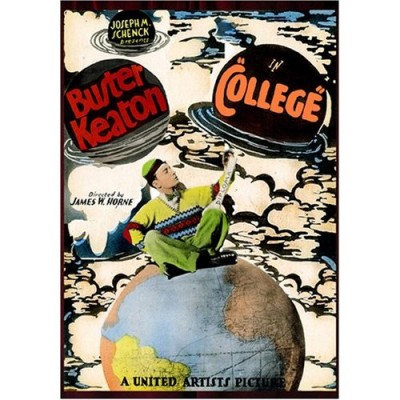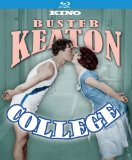| Reviews & Columns |
|
Reviews DVD TV on DVD Blu-ray 4K UHD International DVDs In Theaters Reviews by Studio Video Games Features Collector Series DVDs Easter Egg Database Interviews DVD Talk Radio Feature Articles Columns Anime Talk DVD Savant Horror DVDs The M.O.D. Squad Art House HD Talk Silent DVD
|
DVD Talk Forum |
|
|
| Resources |
|
DVD Price Search Customer Service #'s RCE Info Links |
|
Columns
|
|
|
College
Kino's Blu-ray of College, originally a United Artists release, sources a combination of 35mm elements and generally looks quite good. There are numerous extra features, including The Scribe (1966), a 30-minute industrial film that marked Keaton's final film appearance.
The plot of this 65-minute feature is slight, to say the least. Keaton plays Ronald*, the "most brilliant scholar" of his high school graduating class. He's in love with Mary Haynes (Anne Cornwall, also in Laurel & Hardy's Men O' War) but she fancies Jeff (Harold Goodwin), the school's popular star athlete. Ronald's commencement speech, "The Curse of the Athlete," further strains his relationship with Mary.
All three attend Clayton College, though Ronald has to work his way through college, first as a soda jerk and later as a black waiter at a restaurant. (Caucasian Ronald disguises his race by working in blackface.) Later, he tries to find himself a suitable sport in which to impress his girl. After a disastrous attempt at college baseball, Ronald tries various track and field events, again with no success. Finally, an understanding, supportive Dean Edwards (Snitz Edwards, also prominent in Seven Chances and Battling Butler) compels the rowing team coach to appoint Ronald coxswain for an upcoming race. (Also on the team is Charlie Hall, frequently a foil for Laurel & Hardy.)
College follows the basic plot of The Freshman and, reportedly, footage was shot but later removed of Ronald trying his hand at football, of which some evidence remains in the finished film. After the boat race, Ronald rushes to Mary's rescue, instinctively overcoming physical obstacles that mirror the same track and field events he had so miserably failed at before. During this scene, Ronald storms through a crowd like a running back, the only gag that doesn't directly reference a sport Ronald had tried earlier.
The material doesn't suit Keaton particularly. Lloyd's "Glasses" persona, the handsome but awkward young lad trying to make good, was a perfect fit for The Freshman, with much of the plot revolving around Harold's burning desire to become popular ("Step right up and call me Speedy!"). Keaton's Ronald has no such ambition, as he's the same unsentimental, deadpan misfit disinterested in "fitting in" with the other fellas. Lloyd and Keaton were both 32 years old when they made their respective films, but where Keaton is obviously way too old to be believed as a college freshman (or high school senior!) Lloyd's youthful, indefatigable drive and enthusiasm somehow make him totally believable in his role.
Keaton's attempts at sports lack the inspired gags of his other silent features. Here, Ronald simply isn't good at anything. When he tries the hurdles, for instance, Ronald merely knocks them over. Attempting the high jump, Ronald repeatedly crashes into the horizontal bar and has trouble placing the dislodged bar back into position. Particularly disappointing is the baseball sequence. Off the set Keaton was an avid player and also famously worked out all manner of wild sight gags for various Hollywood charity events. In College, Ronald just isn't any good at the sport.
There are no big set pieces like the massive chase and runaway boulders of Seven Chances or the destructive tornado seen in Steamboat Bill, Jr.. The corner-cutting is especially apparent in the Visual Essay included as an extra feature, where it's revealed that except for the climatic boat race, nearly the entire picture was shot in and around Keaton's Hollywood studio or at real colleges a short drive away.
The very episodic picture does have its bright spots, however. The opening scene has Ronald making the mistake of sitting with his back to the radiator so that his rain-soaked suit shrinks to child-size proportions. Even funnier, delivering the commencement address, he tries to not draw attention to his still-shrinking, increasingly stiff wardrobe. Another early scene has a good set-up, showing a whiz soda jerk making drinks and ice cream dishes with a juggler's grace. Later, Ronald's attempts to do likewise are a disaster, with Keaton's deliberate clumsiness expertly timed.
(Spoilers): Also worth noting is the picture's bizarrely downbeat ending, where the happy young lovers Ronald and Mary become a bitter old couple before being buried in adjacent graves for the fade-out. ("What's that, Daddy?" my daughter asked. I didn't have the heart to tell her.)
Video & Audio
In 1.33:1 full-frame and its original black and white from 35mm elements, College looks pretty good throughout, despite a super-thin line that runs horizontally across the bottom of the frame, undoubtedly a printing error possibly as old as the film itself. In a few scenes other film elements are sourced and the line disappears. It's not a major distraction but it's noticeable. A John Muri theater organ score in 2.0 PCM uncompressed stereo accompanies the picture.
Extra Features
Rob Farr, a silent film festival director, provides an audio commentary, and there's a truly fascinating video essay by John Bengston on College's Los Angeles (and Newport Beach) locations. I had to run it twice it was so interesting, once with Bengston's commentary, a second time to freeze-frame all the amazing stills accompanying it.
Finally, for the disc and for Keaton himself, there's The Scribe, the kind of industrial film that would be totally forgotten were it not for Keaton's appearance. In such films Keaton (sometimes in partnership with his devoted wife, Eleanor) worked out all the gags and usually directed his scenes without credit, and in The Scribe there are little bits and pieces harking back to Keaton's earliest two-reelers. It's not exactly One Week or Cops, but not a bad note to end on.
Parting Thoughts
Even second-rate Buster Keaton is better than, say, first-rate Joe DeRita, and College is a lot of fun even if it's not in the same league as Keaton's best silent features. The transfer and extra features are terrific and, while mildly disappointing, this still comes Highly Recommended.
* Though clearly identified during the film, the credits list characters named only "A Son," "The Girl," "A Rival," etc.
Stuart Galbraith IV is a Kyoto-based film historian whose work includes film history books, DVD and Blu-ray audio commentaries and special features. Visit Stuart's Cine Blogarama here.
|
| Popular Reviews |
| Sponsored Links |
|
|
| Sponsored Links |
|
|
| Release List | Reviews | Shop | Newsletter | Forum | DVD Giveaways | Blu-Ray | Advertise |
|
Copyright 2024 DVDTalk.com All Rights Reserved. Legal Info, Privacy Policy, Terms of Use,
Manage Preferences,
Your Privacy Choices | |||||||













